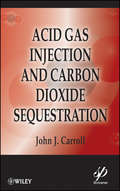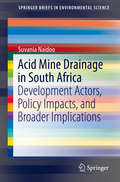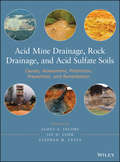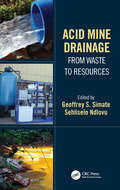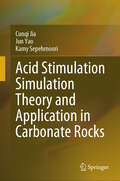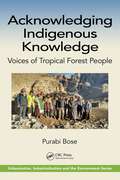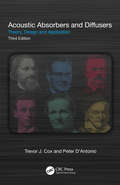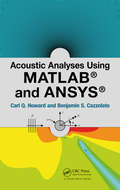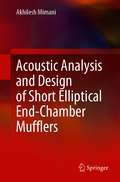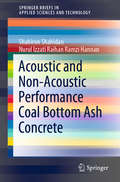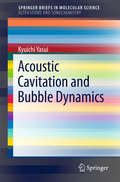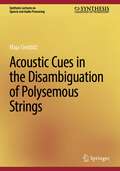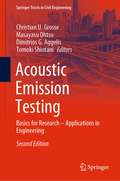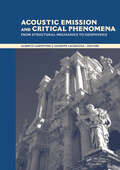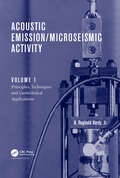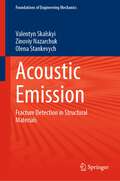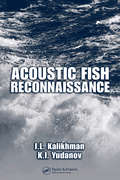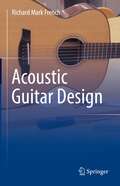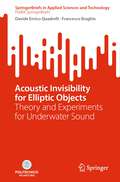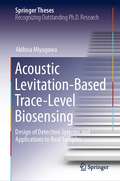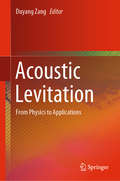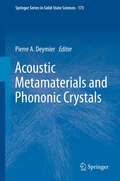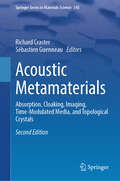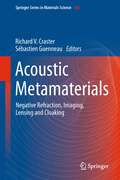- Table View
- List View
Acid Gas Injection and Carbon Dioxide Sequestration
by John J. CarrollProvides a complete treatment on two of the hottest topics in the energy sector - acid gas injection and carbon dioxide sequestration This book provides the most comprehensive and up-to-date coverage of two techniques that are rapidly increasing in importance and usage in the natural gas and petroleum industry - acid gas injection and carbon dioxide sequestration. The author, a well-known and respected authority on both processes, presents the theory of the technology, then discusses practical applications the engineer working in the field can implement. Both hot-button issues in the industry, these processes will help companies in the energy industry "go green," by creating a safer, cleaner environment. These techniques also create a more efficient and profitable process in the plant, cutting waste and making operations more streamlined. This outstanding new reference includes: Uses of acid gas injection, the method of choice for disposing of small quantities of acid gas Coverage of technologies for working towards a zero-emission process in natural gas production A practical discussion of carbon dioxide sequestration, an emerging new topic, often described as one of the possible solutions for reversing global warming Problems and solutions for students at the graduate level and industry course participants
Acid Mine Drainage in South Africa: Development Actors, Policy Impacts, and Broader Implications (SpringerBriefs in Environmental Science)
by Suvania NaidooThis SpringerBrief focuses on Acid Mine Drainage (AMD) in the three basins in the Witwatersrand, South Africa. It provides a background to AMD and its impactsfrom a social science perspective. The South African government and non-governmental organizations' response to AMD is assessed, as well the socio-economic and developmental effects of AMD. This volume, which is based on the author's Master's dissertation at UNISA, involves interviews with a range of experts in the field from government departments, environmental organisations (activists), the private sector (mining), tourism sector and the agricultural sector. The book discusses existing policy documents on AMD and provides recommendations in response to the many socio-economic impacts which have not been fully addressed. A literature review on the global context of AMD is provided. South Africa's water systems are already severely harmed by climate change, different forms of pollution, and poorly managed sanitation systems. For these reasons, the country is becoming increasingly water-stressed and therefore, water will continue to become much scarcer in the future. As a result of AMD's continued impact on South Africa's water systems, as a technical or scientific matter as well as the policy implications for the mining sector, water security and socio-economic sustainability has become a highly contested issue.
Acid Mine Drainage, Rock Drainage, and Acid Sulfate Soils
by James A. Jacobs Jay H. Lehr Stephen M. TestaProvides the tools needed to analyze and solve acid drainage problemsFeaturing contributions from leading experts in science and engineering, this book explores the complex biogeochemistry of acid mine drainage, rock drainage, and acid sulfate soils. It describes how to predict, prevent, and remediate the environmental impact of acid drainage and the oxidation of sulfides, offering the latest sampling and analytical methods. Moreover, readers will discover new approaches for recovering valuable resources from acid mine drainage, including bioleaching.Acid Mine Drainage, Rock Drainage, and Acid Sulfate Soils reviews the most current findings in the field, offering new insights into the underlying causes as well as new tools to minimize the harm of acid drainage:Part I: Causes of Acid Mine Drainage, Rock Drainage and Sulfate Soils focuses on the biogeochemistry of acid drainage in different environments.Part II: Assessment of Acid Mine Drainage, Rock Drainage and Sulfate Soils covers stream characterization, aquatic and biological sampling, evaluation of aquatic resources, and some unusual aspects of sulfide oxidation.Part III: Prediction and Prevention of Acid Drainage discusses acid-base accounting, kinetic testing, block modeling, petrology, and mineralogy studies. It also explains relevant policy and regulations.Part IV: Remediation of Acid Drainage, Rock Drainage and Sulfate Soils examines both passive and active cleanup methods to remediate acid drainage.Case studies from a variety of geologic settings highlight various approaches to analyzing and solving acid drainage problems. Replete with helpful appendices and an extensive list of web resources, Acid Mine Drainage, Rock Drainage, and Acid Sulfate Soils is recommended for mining engineers and scientists, regulatory officials, environmental scientists, land developers, and students.
Acid Mine Drainage: From Waste to Resources
by Sehliselo Ndlovu Geoffrey S. SimateAcid mine drainage (AMD) is essentially the flow of water polluted with metals and other substances from existing/old mining areas and is considered to be one of the sources of pollution. A wide range of technologies are available for preventing AMD generation and/or treating AMD before discharge, but there is a shift towards recovery of industrially useful materials and products from AMD. Acid Mine Drainage: From Waste to Resources explores novel methods developed for the reuse and/or recovery of industrially useful materials from AMD including discussing generation, prediction, prevention, and remediation processes. It includes legislation and policy frameworks governing AMD and its environmental/health impacts. Provides a detailed overview of the mining operations and discusses the geochemical and hydrogeological context of acid mine drainage AMD formation, prediction and impact Presents a holistic approach to AMD generation, prediction, prevention, and remediation processes Presents exclusive material on reuse, recycling, and recovery of industrially useful materials from AMD Gives a detailed overview of the legislation and policy regulatory framework governing the management of AMD Analyses the effects of AMD on the environment and health This volume is aimed at researchers and professionals in metallurgical engineering, chemical engineering, environmental engineering, and mining engineering, including policy makers.
Acid Stimulation Simulation Theory and Application in Carbonate Rocks
by Jun Yao Cunqi Jia Kamy SepehrnooriThis book provides a theoretical basis and technical support for carbonate acid stimulation design. Carbonate reservoirs are one of the most important sources of fossil fuels. Acid stimulation is an effective technique for enhancing reservoir performance and boosting production. The book stands as a fundamental guide in implementing acid stimulation techniques in carbonate reservoirs. It models the acid stimulation process, contemplating mass, momentum, and energy changes alongside the real mineral composition of the carbonate rock matrix. Comprehensive sensitivity studies are conducted to elucidate the targeted mechanisms and optimization principles for designing acid stimulation applications in carbonate reservoirs. This book also serves as an excellent foundation for numerical simulation, providing detailed descriptions of how finite volume methods and sequential decoupling algorithms are utilized for numerical discretization and solving decoupled solutions on staggered grids. This book is an essential reference for reservoir engineers, academics, and students interested in studying and performing acid stimulation in carbonate reservoirs. It also helps readers obtain an understanding of modeling reactive flow in porous media with coupling multi-physical fields, including hydrologic–chemical-thermal processes and multi-scale characteristics. In addition, this book also delves into scale-up methods, such as the fundamental theoretical foundations and important theorems of the volume averaging approach. The book is used as a textbook for senior undergraduate and graduate courses in petroleum engineering.
Acknowledging Indigenous Knowledge: Voices of Tropical Forest People (Urbanization, Industrialization, and the Environment)
by Purabi BoseThis book explores how the landscapes in indigenous territories are rapidly changing due to increased global industrial demand. This deforestation and urbanization have isolated the indigenous people from practicing ‘traditional ways of life.’ Portrayed in this book is the indigenous people’s perspective of their indigenous knowledge (IK) about the environment and why losing IK is a threat to humans, wildlife, and nature. Insight is shared into why acknowledging IK as a science can help solve climate change, food and nutrition insecurity, and increasing new types of pandemics through evidence‑based stories from indigenous people. Features:• Bridges the fractured space between science and nature.• Documents the perspectives of indigenous peoples about their ancestral knowledge.• Provides ethnographic qualitative comparative case studies of forest‑dwelling indigenous peoples over a 19‑year period.• Covers largely remote indigenous territories of ten tropical countries in the Global South.• Provides evidence‑based stories examining indigenous knowledge’s role in the tropics in preserving diverse landscapes and providing nature‑based solutions.
Acoustic Absorbers and Diffusers: Theory, Design and Application
by Trevor Cox Peter D’AntonioThis definitive guide covers the design and application of absorbers and diffusers in acoustics. Surface diffusion is a relatively young subject area, and diffuser design, application and characterisation are often not well understood. Although there is greater knowledge of absorption, it is also informed by new research. As two of the main design tools for altering the acoustic conditions of rooms, the correct use of absorbers and diffusers is important to the creation of quality acoustics. This text details the evolution and the current state of the art in diffuser and absorber research and application. It covers a range of practical and theoretical aspects, with extensive examples of installations and case studies to cater to practitioners working in the measurement, modelling and design of rooms, semi-enclosed spaces as well as in noise control. It is also invaluable for students and researchers wanting a grounding in acoustic treatment, as well as understanding the latest developments. All chapters have been revised and brought up to date in this new edition, with new applications, absorbers and diffusers featured. Sustainability, portable vocal booths, and fast time domain models for diffusers are just a few of the new sections. Improved techniques for measurement and prediction are included, as well as bringing old methods up-to-date with the latest refinements from standards and research. Most of the prediction methods in the book are now linked to open source implementations and downloadable MATLAB scripts, enabling readers to exploit the knowledge in this book more readily in design and research.
Acoustic Analyses Using Matlab and Ansys
by Carl Howard Benjamin CazzolatoThis book describes the use of ANSYS finite element analysis software and MATLAB to solve acoustic problems. These range from simple textbook problems, to complex ones that can only be solved using FEA software. The book includes instructions on relevant mathematical modelling, and hints on the use of ANSYS software. The MATLAB source code provides readers with valuable tools for doing their own validations, and is available for download. The book provides practical training in the use of FEA for basic modelling and solving acoustic problems.
Acoustic Analysis and Design of Short Elliptical End-Chamber Mufflers
by Akhilesh MimaniThis book presents a three-dimensional analysis of acoustic wave propagation in an elliptical waveguide, and applies the equations and concepts to design axially short elliptical end-chamber muffler configurations which are an important component of a complex multi-pass muffler used in a modern-day automotive exhaust system. A general solution of the Helmholtz equation in elliptical cylindrical co-ordinates is presented in terms of the Mathieu and modified Mathieu modal functions. This is followed by the tabulation and analysis, for the first time, of the non-dimensional resonance frequencies of the transverse modes of a rigid-wall elliptical waveguide for a complete range of aspect ratio. The modal shape patterns of the first few circumferential, radial and cross-modes are examined with particular attention to the pressure nodal ellipses and hyperbolae. An analytical formulation is then outlined for characterizing a single-inlet and single-outlet elliptical muffler with the inlet located on the end face and the outlet located either on the end face or side-surface. The ensuing chapter is devoted toward analyzing the Transmission Loss (TL) performance of different short end-chamber mufflers, namely (a) the straight-flow configuration having ports located on the opposite face, (b) the flow-reversal configuration with ports located on the same end face and (c) configuration with inlet port on the end face and outlet on the side surface. Design guidelines are formulated in terms of the optimal location of inlet and outlet ports which suppresses the deteriorating influence of certain higher-order modes, thereby delivering a broadband TL performance. Directions for future work are discussed toward the end. In summary, this book is a one-stop solution for a practicing automotive engineer designing mufflers, for an applied mathematician studying wave propagation in elliptical geometries, and also as a niche area within noise control engineering.
Acoustic And Non-Acoustic Performance Coal Bottom Ash Concrete (SpringerBriefs in Applied Sciences and Technology)
by Shahiron Shahidan Nurul Izzati Raihan Ramzi HannanThis book highlights the acoustic performance of concrete made with Coal Bottom Ash (CBA) that has contributed to environmental issues. The usage of CBA in concrete can be recommended as good concrete due to its absorption properties. This book focuses on the principles and techniques employed in acoustic design. The book first elaborates on the perception of noise and properties of noise, followed by physical data, units and measurements. Finally, it takes a look at acoustic analysis which includes acoustic performance effects using different volumes of CBA, density and porosity of concrete.
Acoustic Cavitation and Bubble Dynamics (SpringerBriefs in Molecular Science)
by Kyuichi YasuiThis brief explains in detail fundamental concepts in acoustic cavitation and bubble dynamics, and describes derivations of the fundamental equations of bubble dynamics in order to support those readers just beginning research in this field. Further, it provides an in-depth understanding of the physical basis of the phenomena. With regard to sonochemistry, the brief presents the results of numerical simulations of chemical reactions inside a bubble under ultrasound, especially for a single-bubble system and including unsolved problems. Written so as to be accessible both with and without prior knowledge of fundamental fluid dynamics, the brief offers a valuable resource for students and researchers alike, especially those who are unfamiliar with this field. A grasp of fundamental undergraduate mathematics such as partial derivative and fundamental integration is advantageous; however, even without any background in mathematics, readers can skip the e quations and still understand the fundamental physics of the phenomena using the book's wealth of illustrations and figures. As such, it is also suitable as an introduction to the field.
Acoustic Cues in the Disambiguation of Polysemous Strings (Synthesis Lectures on Speech and Audio Processing)
by Maja GwóźdźThis book provides an analysis of acoustic features of polysemous strings and an implementation of a speech disambiguation program based on the phonetic information. Throughout the book, the term ‘polysemous string’ refers to idioms with plausible literal interpretations, restrictive and non–restrictive relative clauses, and the same expressions used as quotations and appearing in a non–quotational context. The author explains how, typically, context is sufficient to determine the intended meaning. But there is enough evidence in psycholinguistic and phonetic literature to suspect that these superficially identical strings exhibit different acoustic features. In the experiment presented in the book, the participants were asked to read short excerpts containing corresponding elements of polysemous strings placed in the same intonational position. The acoustic analyses of ditropic pairs and subsequent statistical tests revealed that there is almost no difference in the duration, pitch, or intensity in literal and figurative interpretations. However, the analysis of relative clauses and quotations demonstrated that speakers are more likely to use acoustic cues to differentiate between the two possible readings. The book argues that the acoustic analysis of polysemous phrases could be successfully implemented in designing automatic speech recognition systems in order to improve their performance in disambiguating polysemous phrases.Analyzes acoustic features of polysemous strings and an implementation of a speech disambiguation programIncludes evidence that superficially identical strings exhibit different acoustic featuresArgues that acoustic analysis of polysemous phrases can be successfully implemented in automatic speech recognition
Acoustic Emission Testing: Basics for Research – Applications in Engineering (Springer Tracts in Civil Engineering)
by Masayasu Ohtsu Christian U. Grosse Dimitrios G. Aggelis Tomoki ShiotaniThis book provides an introduction to Acoustic Emission Testing and its applications to different materials like concrete, steel, ceramics, geotechnical materials, polymers, biological structures and wood. Acoustic Emission Techniques (AET) techniques have been studied in engineering for a long time. The techniques are applied more and more to practical investigations and are more and more standardized in codes. This is because the degradation of structures due to ageing urgently demand for maintenance and rehabilitation of structures in service. It results in the need for the development of advanced and efficient inspection techniques. In mechanical engineering and concerning the monitoring of machines and mechanical components, AE is a widely accepted observing deterioration in the frame of structural health monitoring. The advantages of AE like sensitivity, damage localization potential, non-intrusive nature as well as developments in signal analysis and data transmission allow applications that could not be considered decades ago.As such, AE techniques draw great attention to diagnostic applications and in material testing. This book covers all levels from the description of AE basics for AE beginners (level of a student) to sophisticated AE algorithms and applications to real large-scale structures as well as the observation of the cracking process in laboratory specimen to study fracture processes. This book has proved its worth over the past twelve years. Now in its second edition, it will be a resource that sets the standard and equips readers for the future. All chapters from the 1st edition have been updated and rewritten and eight extra chapters (e.g also regarding AE tomography, AE in plate-like structures and AE for investigations of hardening of fresh concrete) have been added.
Acoustic Emission and Critical Phenomena: From Structural Mechanics to Geophysics
by Alberto Carpinteri Giuseppe LacidognaThe Acoustic Emission (AE) technique uses ad hoc transducers to detect AE events caused by crack growth in structures under external loading. This technique is similar to the one employed in earthquake control, where seismic waves reach the monitoring stations placed on the surface of the Earth. And although they take place on different scales, the
Acoustic Emission/Microseismic Activity: Volume 1: Principles, Techniques and Geotechnical Applications
by Jr., H. HardyA study of topics related to acoustic emission/microseismic (AE/MS) activity. It covers basic material behaviour, stress wave propagation, transducer design and installation, electronic instrumentation, data acquisition and analysis, and signal processing, as well as practical applications.
Acoustic Emission: Fracture Detection in Structural Materials (Foundations of Engineering Mechanics)
by Zinoviy Nazarchuk Valentyn Skalskyi Olena StankevychThe book presents topical theoretical and experimental studies for developing advanced methods of detecting materials fracture and assessing their structural state using acoustic emission. It introduces new mathematical models characterizing the displacement fields arising from crack-like defects and establishes a new criterion for classifying different types of materials fracture based on specific parameters obtained from wavelet transforms of acoustic emission signals. The book applies this approach to experimental studies in three types of materials—fiber-reinforced composites, dental materials, and hydrogen-embrittled steels.
Acoustic Fish Reconnaissance
by I.L. Kalikhman K. I. YudanovUntil now, there has not been any work that systematically presents the subject of acoustic fish reconnaissance, details all major aspects of applying acoustic equipment in commercial fish reconnaissance, and offers sufficient analysis of the effectiveness of fish-finding techniques. Acoustic Fish Reconnaissance responds to this need by providing t
Acoustic Guitar Design
by Richard Mark FrenchThis book is for experienced luthiers and guitar designers in the industry, novice builders wishing to improve their designs, and guitar owners interested in knowing more about their instruments. It includes the most important technical information gathered from many sources, including the academic literature and the author’s own work, presented here in a clear, actionable form with a minimum of mathematics. The book begins with a historical survey on how important features of the acoustic guitar evolved over centuries. The review leads up to a chapter focusing on three iconic instruments that represent the most important types of acoustic guitars: classical, steel string flat top and archtop. As the guitar market is so strongly conditioned by familiar, traditional instruments, a successful builder must have a thorough working understanding of the most important designs to underpin their own work. Through this volume, Professor French lays out the entire design process and collects detailed information in one convenient source. Luthiers quite often compile notebooks of measurements, part numbers, specific design features and other details they routinely need. This book organizes much of that information, with tables of dimensions, material properties, and other details in one essential final chapter. The book also features concise side bar contributions by top guitar designers and builders including Tim Shaw, Chief Engineer at Fender Music; Bob Taylor, Co-Founder of Taylor Guitars; and Andy Powers, Master Guitar Designer and Partner.
Acoustic Invisibility for Elliptic Objects: Theory and Experiments for Underwater Sound (SpringerBriefs in Applied Sciences and Technology)
by Francesco Braghin Davide Enrico QuadrelliThe book investigates acoustic cloaking for elliptical targets, starting from the development of a systematic approach to deal with such non-axisymmetrical shapes by adopting transformation acoustics in elliptic coordinates, and concluding with numerical and experimental validation of a microstructured cloak in the underwater environment. The book thus comprises all the steps from theory to practice that led to the first experimental validation of acoustic invisibility for non-cylindrical objects, whose results are presented in the last chapter. Indeed, despite Transformation Theory is now an established tool to design material distributions capable to unlock the design of invisibility devices, it is not trivial to apply it for shapes different than the sphere and the cylinder, which are thus the ones mainly addressed in the literature. This book paves the way for exploration of other shapes, demonstrating the effectiveness of a pentamode cloak in reducing the acoustic visibility of an elliptical target, and discussing design choices that can make the implementation of the required microstructure less cumbersome despite the lack of axial symmetry of the problem, from both the numerical and manufacturing point of views.
Acoustic Levitation-Based Trace-Level Biosensing: Design of Detection Systems and Applications to Real Samples (Springer Theses)
by Akihisa MiyagawaThis book shows the availability and potential of the coupled acoustic-gravitational (CAG) field for trace-level biosensing. The proposed detection scheme also allows the evaluation of the kinetics and thermodynamics of the reaction occurring on a single microparticle (MP). This method has wide applicability in important fields, involving not only chemistry but also life, environmental, and medical sciences. The author proposes novel trace-level biosensing based on measurements of the levitation coordinate shift of an MP in the CAG field. The levitation coordinate of the MP in the CAG field is determined by its density and compressibility. The levitation coordinate shift is induced by the binding of gold nanoparticles (AuNPs) to the MP through interparticle reactions. Therefore, the quantity of molecules involved in the reaction can be determined from the levitation coordinate shift. The author demonstrates the zmol level detection for biotin, DNA/RNA, and organic molecules. In addition, the kinetics and thermodynamics are evaluated for various reactions occurring between the MP and AuNP, such as the avidin-biotin reaction, direct hybridization, sandwich hybridization, and aptamer-target complexation.This book provides a new concept based on the CAG field, in which the extent of a reaction is converted into the levitation coordinate shift, that is, “length.” The proposed method has many advantages over other methods, e.g., high biocompatibility, high applicability, and short analysis time. In addition, because the apparatus used in this study is inexpensive and easy to miniaturize, this method is useful in important practical fields, such as forensic and environmental science and diagnosis. Thus, this book inspires many researchers to apply the present method to their own fields of interest.
Acoustic Levitation: From Physics to Applications
by Duyang ZangThis book systematically introduces readers to the fundamental physics and a broad range of applications of acoustic levitation, one of the most promising techniques for the container-free handling of small solid particles and liquid droplets. As it does away with the need for solid walls and can easily be incorporated into analysis instruments, acoustic levitation has attracted considerable research interest in many fields, from fluid physics to material science. The book offers a comprehensive overview of acoustic levitation, including the history of acoustic radiation force; the design and development of acoustic levitators; the technology’s applications, ranging from drop dynamics studies to bio/chemical analysis; and the insightful perspectives that the technique provides. It also discusses the latest advances in the field, from experiments to numerical simulations. As such, the book provides readers with a clearer understanding of acoustic levitation, while also stimulating new research areas for scientists and engineers in physics, chemistry, biology, medicine and other related fields.
Acoustic Metamaterials and Phononic Crystals (Springer Series in Solid-State Sciences #173)
by Pierre A. DeymierThis comprehensive book presents all aspects of acoustic metamaterials and phononic crystals. The emphasis is on acoustic wave propagation phenomena at interfaces such as refraction, especially unusual refractive properties and negative refraction. A thorough discussion of the mechanisms leading to such refractive phenomena includes local resonances in metamaterials and scattering in phononic crystals.
Acoustic Metamaterials: Absorption, Cloaking, Imaging, Time-Modulated Media, and Topological Crystals (Springer Series in Materials Science #345)
by Sébastien Guenneau Richard CrasterThe revised edition of this book offers an expanded review of acoustic metamaterials; novel materials which can manipulate sound waves, surface Rayleigh waves and water waves, in surprising ways, which include collimation, focusing, negative refraction, passive and active cloaking, sonic screening and extraordinary transmission. It covers both experimental and theoretical aspects of acoustic and elastic waves propagating in structured composites, with a focus on effective properties associated with negative refraction, lensing and cloaking. Updated chapters cover filtering effects, extraordinary transmission, sub-wavelength imaging via tomography or time-reversal techniques, cloaking via transformation acoustics, elastodynamics, and acoustic scattering cancellation. For this revised edition, six new chapters have been introduced to reflect recent developments in experimental acoustics and metasurfaces including acoustic impedance gratings and mirror symmetric metamaterials, phononic subsurfaces, time-modulated and topological crystals. The latter two are illustrated by simple Python program examples. The broad scope gives the reader an overview of the state of the art in acoustic metamaterials research and an indication of future directions and applications. It will serve as a solid introduction to the field for advanced students and researchers in physics, applied mathematics and mechanical engineering, and a valuable reference for those working in metamaterials and related areas.
Acoustic Metamaterials: Negative Refraction, Imaging, Lensing and Cloaking (Springer Series in Materials Science #166)
by Richard V. Craster Sébastien GuenneauAbout the book: This book is the first comprehensive review on acoustic metamaterials; novel materials which can manipulate sound waves in surprising ways, which include collimation, focusing, cloaking, sonic screening and extraordinary transmission. It covers both experimental and theoretical aspects of acoustic and elastic waves propagating in structured composites, with a focus on effective properties associated with negative refraction, lensing and cloaking. Most related books in the field address electromagnetic metamaterials and focus on numerical methods, and little (or no) experimental section. Each chapter will be authored by an acknowledged expert, amongst the topics covered will be experimental results on non-destructive imaging, cloaking by surface water waves, flexural waves in thin plates. Applications in medical ultrasound imaging and modeling of metamaterials will be emphasized too. The book can serve as a reference for researchers who wish to build a solid foundation of wave propagation in this class of novel materials.
Acoustic Modeling for Emotion Recognition (SpringerBriefs in Speech Technology)
by Koteswara Rao Anne Swarna Kuchibhotla Hima Deepthi VankayalapatiThis book presents state of art research in speech emotion recognition. Readers are first presented with basic research and applications - gradually more advance information is provided, giving readers comprehensive guidance for classify emotions through speech. Simulated databases are used and results extensively compared, with the features and the algorithms implemented using MATLAB. Various emotion recognition models like Linear Discriminant Analysis (LDA), Regularized Discriminant Analysis (RDA), Support Vector Machines (SVM) and K-Nearest neighbor (KNN) and are explored in detail using prosody and spectral features, and feature fusion techniques.
